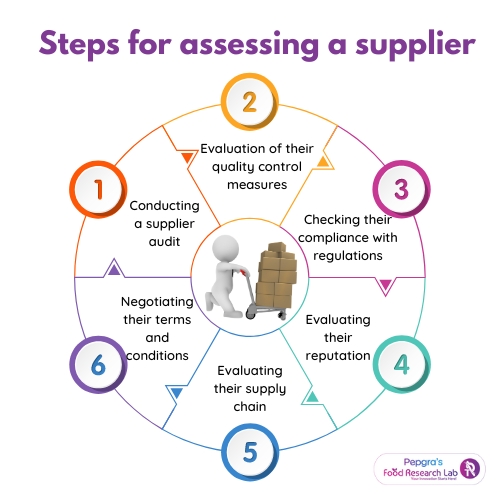
Assessing Raw Material Suppliers Before Onboarding: Best Practices and Strategies
Introduction
Food safety is regarded as the most important quality by consumers. The formulators of Fast Moving Consumer Goods (FMCG) should be concerned with the standard of raw materials used in production, for it directly correlates with product acceptance. Among the various facets of the food industry, suppliers are essential. Several elements affect the end product’s quality, and a supplier qualification list is one of the most crucial resources for guaranteeing high-quality raw materials. The best strategy to keep threats away from the food and the manufacturing facility is to ensure that incoming raw materials are risk-free. Scrutinizing food and beverage, nutraceuticals, and raw materials suppliers before onboarding them is crucial to ensure that the products are high-quality, safe, and meet regulatory requirements.
Assessment of suppliers
The following are some steps that can be taken to scrutinize potential suppliers:

- Conduct a supplier audit: Before onboarding any supplier, it is essential to conduct an audit to evaluate their facilities, processes, and quality control measures. This can be done by reviewing their certifications, conducting on-site visits, and evaluating their documentation.
- Evaluate their quality control measures: Ensure that the supplier has a robust quality control program in place, which includes regular testing of raw materials, in-process testing, and finished product testing. Review their testing protocols and ensure they meet regulatory requirements [1].
- Check their compliance with regulations: Ensure that the supplier is compliant with all relevant regulations, including FDA regulations, GMPs, and other applicable standards. Review their documentation, including certifications, audit reports, and other relevant information [2].
- Evaluate their reputation: Check the supplier’s reputation in the industry by reviewing their customer feedback, online reviews, and other relevant information. Working with suppliers with a positive reputation and a history of providing high-quality products is vital.
- Evaluate their supply chain: Review the supplier’s supply chain to ensure they are sourcing their raw materials from reputable sources. It is crucial to work with suppliers who are transparent about their supply chain and can provide documentation to support their claims.
- Negotiate terms and conditions: Once a supplier has been selected, negotiate terms and conditions, including pricing, delivery schedules, and other relevant factors. It is essential to have an explicit agreement to ensure that both parties understand their obligations [3].
Conclusion Scrutinizing potential suppliers is critical in ensuring that food and beverage, nutraceutical, and raw material products are high quality, safe, and meet regulatory requirements. By following these steps, organizations can select suppliers who meet their needs and can help them achieve their goals. The Food Research Lab sourcing and procurement services. After a thorough assessment, it selects suppliers and ensures the raw materials are high-quality for developing food, beverages and nutraceuticals.





